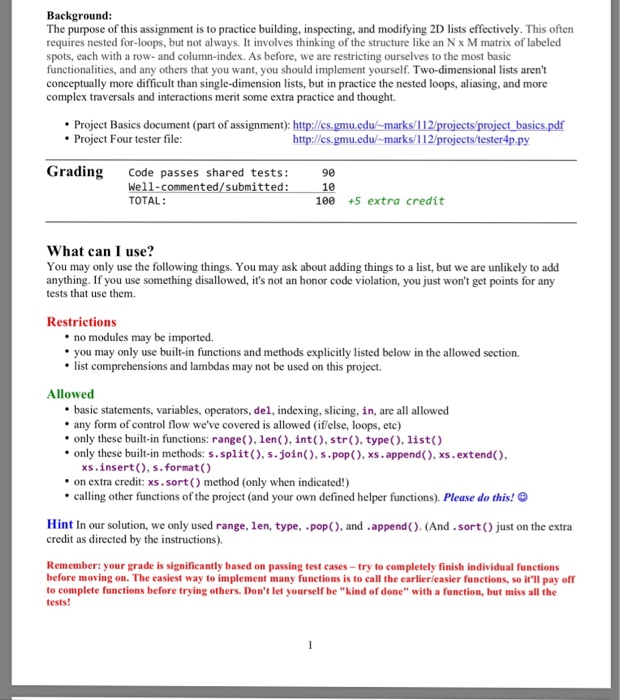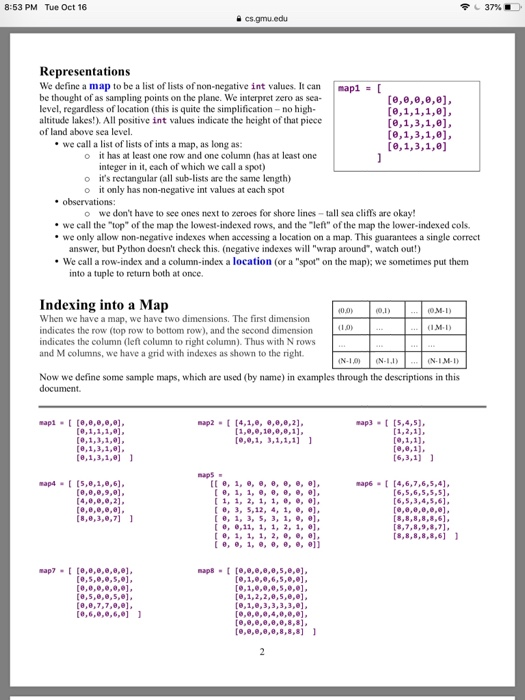Answered step by step
Verified Expert Solution
Question
1 Approved Answer
PYHTON CODING FUNCTIONS HELP Part 2. Also need help with these last functions. Requirements/restraints and the map referred to is pictured in the screenshot. Need
PYHTON CODING FUNCTIONS HELP Part 2. Also need help with these last functions. Requirements/restraints and the map referred to is pictured in the screenshot. Need help with these 4 tasks:
Function 4:
def is_map(map) : given a map (see screenshot), does it meet the following criteria? 1) it is a list of lists of values of type int; 2) it has at least one row and one column; 3) its rectangular (all sub-lists are same length); 4) only non-negative ints are present (zero and up is accepted)
Assume: map is a list.
is_map([[1,2,3],[0,1,5]) True
is_map([[[1,2,3,4],[5],[6,7]]) False # not rectangular
is_map([[-2,False, [1,2,3]], [4,5,6]]) False #can't contain negatives or non-ints
Function 5:
def neighbors(map, r, c): Given a map and a location, there are up to eight possible locations immediately around it that might also exist on the map (unless along an edge or corner position). Build up a list of tuples, each tuple storing the (row, column) of the neighbors. They must be in order from lowest-row to later, lowest-column to later. This happens to mean the same ordering as they appear when the map is printed out. If the point isn't on the map, return an empty list!!
Assume: map is a map as defined above, and r and c are int values.
neighbors(map1,1,1) [(0, 0), (0, 1), (0, 2), (1, 0), (1, 2), (2, 0), (2, 1), (2, 2)]
neighbors(map2,0,3) [(0, 2), (0, 4), (1, 2), (1, 3), (1, 4)]
neighbors(map2,2,0) [(1, 0), (1, 1), (2, 1)]
Function 6:
def water_adjacent(map, r, c): Given a map and a location, are any of that spot's neighbors water? Water spots do not count themselves, only their neighbors. If (r,c) isn't on the map, the answer is False.
Assume: map is a map as defined above, and r and c are int values.
water_adjacent(map1,1,1) True
water_adjacent(map1,2,2) False
water_adjacent([[1,1,1],[1,0,1],[1,1,1]],1,1) False
Function 7:
def count_coastline(map): Given a map, how many spots are adjacent to water
Assume: map is a map as defined above, and r and c are int values.
count_coastline(map1) 9
count_coastline(map2) 11
count_coastline([[1,1,1],[1,0,1],[1,1,1]]) 8


Step by Step Solution
There are 3 Steps involved in it
Step: 1

Get Instant Access to Expert-Tailored Solutions
See step-by-step solutions with expert insights and AI powered tools for academic success
Step: 2

Step: 3

Ace Your Homework with AI
Get the answers you need in no time with our AI-driven, step-by-step assistance
Get Started


